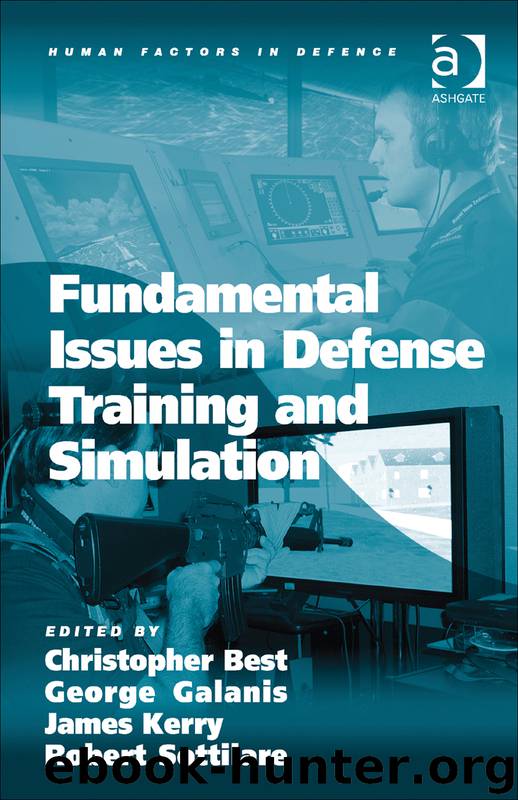Fundamental Issues in Defense Training and Simulation by Christopher Best & George Galanis & James Kerry & Robert Sottilare

Author:Christopher Best & George Galanis & James Kerry & Robert Sottilare
Language: eng
Format: epub
Publisher: Ashgate
Published: 2013-03-14T16:00:00+00:00
Kay Stanney, Meredith Carroll, Roberto Champney, Luke DeVore, and Kelly Hale
Design Interactive, Inc.
Virtual Environment (VE) technologies provide unprecedented opportunities to train skill sets in highly relevant and highly realistic environments. Unfortunately, if not utilized appropriately, VEs can have negligible or even negative effects on training. This chapter will summarize the advantages of using VEs to train, optimal use strategies and techniques, issues which can emerge if not used appropriately, and how to effectively minimize these issues.
Simulators offer an ecologically valid training platform, one that approximates real-life situations that can facilitate perception and interaction in a relatively unconstrained situated learning paradigm that supports consolidated knowledge acquisition (Gibson, 1979; Lave & Wenger, 1990). Such simulated training environments can be virtual (i.e., fully computer-generated), such as for Military Operations in Urban Terrain (MOUT) training, where squads can become engaged in a fully immersive virtual environment and practice building entry and room clearing. They can also be mixed reality systems (i.e., a combination of virtual and physical environments), such as a Joint Terminal Attack Controller (JTAC) trainer that uses real binoculars to view the real world and overlays virtual enemy aircraft onto the view of the binoculars. Such simulated learning environments can enhance the training experience by presenting information via multiple senses, thereby enhancing retrieval of learned information (Schacter, 1996). They can also allow for elaboration and reflection of learned information, which can in turn facilitate assimilation of knowledge in long-term memory (Brown & Kane, 1988; Larson et al., 1985). Further, they can provide complex scenarios that require the application of higher-order strategies during learning, which can lead to enhanced retrieval (Jensen, 1998). However, there are also limitations in the effectiveness of such simulated training environments, as they can overwhelm trainees with complexity if they are not integrated into a curriculum at a point where the learner is receptive (Stanney, Costello, & Kennedy, 2007). In addition, not everyone can comfortably use simulated training environments, as they can lead to malaise and after-effects (e.g., maladaptive compensation such as adaptations in hand-eye coordination, vision, and posture, which are transferred to the real world and may result in a transient loss of normative psychomotor functioning; Champney et al., 2007). Thus, it is essential that simulated training environments be used in such a way that training benefits are maximized while limitations are minimized or altogether overcome.
Download
This site does not store any files on its server. We only index and link to content provided by other sites. Please contact the content providers to delete copyright contents if any and email us, we'll remove relevant links or contents immediately.
Algorithms of the Intelligent Web by Haralambos Marmanis;Dmitry Babenko(8521)
Test-Driven Development with Java by Alan Mellor(7362)
Data Augmentation with Python by Duc Haba(7261)
Principles of Data Fabric by Sonia Mezzetta(7005)
Learn Blender Simulations the Right Way by Stephen Pearson(6942)
Microservices with Spring Boot 3 and Spring Cloud by Magnus Larsson(6774)
RPA Solution Architect's Handbook by Sachin Sahgal(6175)
Hadoop in Practice by Alex Holmes(6030)
The Infinite Retina by Robert Scoble Irena Cronin(5881)
Jquery UI in Action : Master the concepts Of Jquery UI: A Step By Step Approach by ANMOL GOYAL(5872)
Big Data Analysis with Python by Ivan Marin(5700)
Life 3.0: Being Human in the Age of Artificial Intelligence by Tegmark Max(5401)
Pretrain Vision and Large Language Models in Python by Emily Webber(4659)
Infrastructure as Code for Beginners by Russ McKendrick(4443)
WordPress Plugin Development Cookbook by Yannick Lefebvre(4174)
Functional Programming in JavaScript by Mantyla Dan(4123)
The Age of Surveillance Capitalism by Shoshana Zuboff(4114)
Embracing Microservices Design by Ovais Mehboob Ahmed Khan Nabil Siddiqui and Timothy Oleson(3963)
Applied Machine Learning for Healthcare and Life Sciences Using AWS by Ujjwal Ratan(3937)
